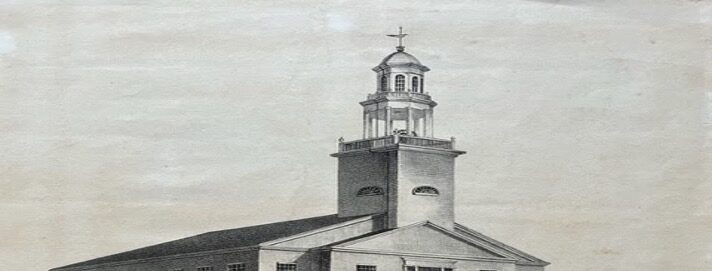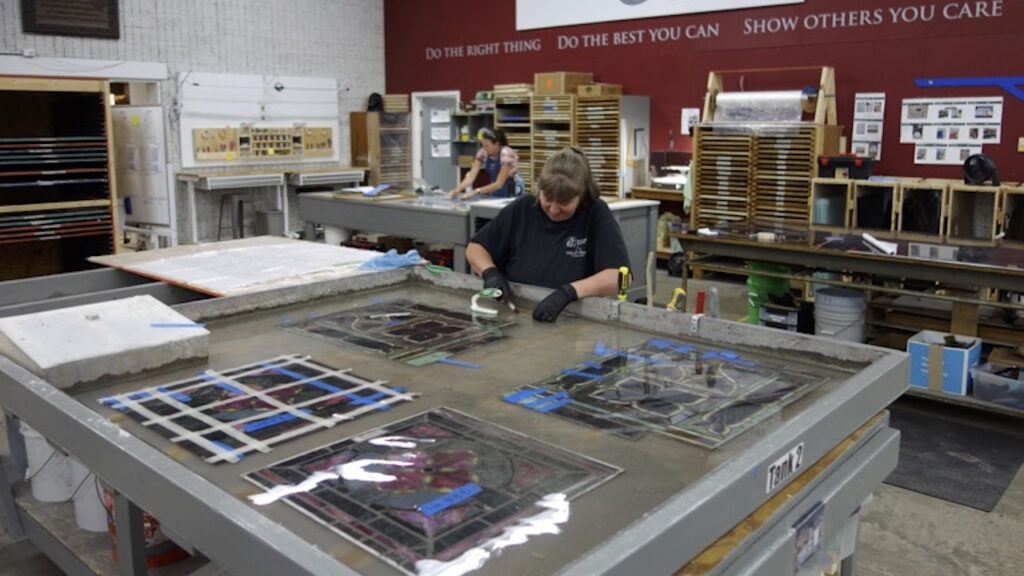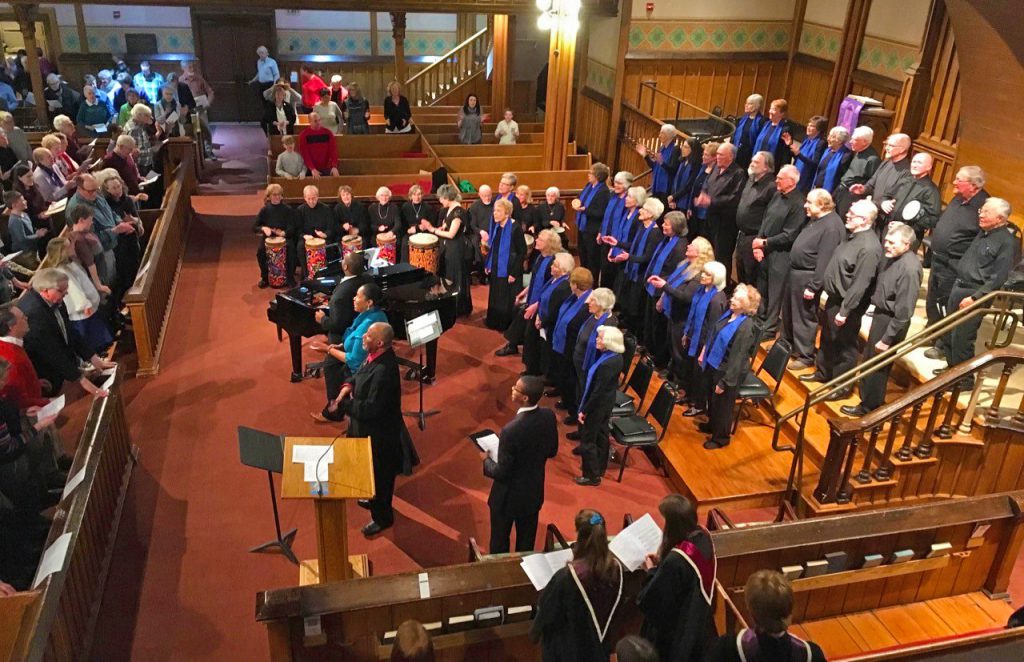By:
NEWS
From the Archives... The Ties that Bind (Part II) - Joshua Chamberlain and First Parish Church

Our focus for July and August has been on Joshua Chamberlain’s personal connections with First Parish Church that started in 1848 when he entered Bowdoin College as a freshman and was required as a Bowdoin student to attend our Sunday services. Unlike many of his fellow schoolmates, Joshua arrived in Brunswick with a strong religious upbringing where his faith had already become an important foundation for him. If you have not taken the opportunity to learn more about him, you can begin by reading July’s archive article on our News section of our church website. That article ended in 1855 at the Bowdoin Commencement where Chamberlain was asked to speak after completing three years at Bangor Theological Seminary. Turning down two church offers to become a pastor upon graduation, instead, he accepted Bowdoin’s offer to teach classes in logic and natural theology that had previously been taught by Professor Calvin Stowe, Harriet’s husband, who had accepted a position at Andover (MA) Seminary. Fanny Adams, Chamberlain’s fiancé, had returned from three years of teaching music at a private school in Georgia with plans to marry. His future father-in-law, our Rev. George Adams, was also an Overseer at Bowdoin and cautioned Chamberlain about the uncertainty of receiving a permanent teaching position at Bowdoin because of the College’s financial concerns. It is assumed that Chamberlain’s worries about providing properly for a wife delayed his marriage to Fanny that fall, but at 4:30 p.m. on December 7, 1855, Chamberlain and Fanny were married in our church by Fanny’s father, Rev. Adams.
That winter Chamberlain’s two younger brothers, Hod and John, began their studies at Bowdoin. According to author Ron White’s book, On Great Fields, Chamberlain was still considering a career as a pastor at this time, but perhaps Fanny’s discomfort in becoming a pastor’s wife and
his enjoyment of teaching kept them in Brunswick. The following October, their daughter was born and Fanny and her baby spent several weeks living with Chamberlain’s parents in Brewer due to the lack of money from Chamberlain’s salary.
Upon the birth of Grace Dupee Chamberlain who was “Daisy” to them, Chamberlain wrote, “In the golden days of the Indian summer of that year, there came to his house an angel of God, who left his living smile – for the loving earth part of the infinite heaven! There was a daughter of the house.” By 1857, they moved into a house on Lincoln Street and soon Fanny gave birth to their son who sadly lived only a few hours. A second son, Harold Wyllys, was born the following year. With a larger family, they moved to the house on Potter Street which is now the Chamberlain museum. According to White, “although the price was $2,100 and a stretch for a young Bowdoin professor, Joseph Badger, president of the Pejepscot Bank, helped with the financing for the house and furnishings with no required repayment date!” Scarlet fever and other illnesses raged through Brunswick prior to Fanny’s birth of their second daughter, Emily, who lived only four months.
As the presidential election of November 1860 approached with Lincoln winning, Chamberlain had a more secure teaching position at Bowdoin. By late December, South Carolina seceded from the Union before six other Southern states joined the Confederate South. It is common agreement that Chamberlain would have continued to attend First Parish Church during those years along with other faculty including his two colleagues and mentors, Professor Alpheus Spring Packard and Professor William Smyth, who had pews in the south transept of our church surrounded above and around by Bowdoin students who were required to attend each Sunday service. Author White wrote of the fall 1861, “Of the sixty-one students in the just-graduated class of 1861, twelve would enlist in the Union army. Two students from North Carolina enlisted on the Confederate side.”
By 1862, Chamberlain felt called to volunteer for the military, although a recent promotion at
Bowdoin offered him a two-year sabbatical in Europe. Instead, he accepted the command of one of the Maine regiments being formed and left his teaching position with Bowdoin’s generous salary! Because our focus is on Chamberlain’s ties to First Parish Church, you can easily learn more about Chamberlain’s military career through numerous books or by visiting our local Chamberlain museum. Instead, we will move to his return following the Civil War, where he had been wounded several times and returned to Brunswick as a celebrated war hero.
In 1867 he was inaugurated as our 32nd Governor of Maine. His wife, Fanny, dug her heels in and remained in Brunswick rather than joining her husband in a boarding house for part of the year in Augusta, so they spent much time apart. Serving four one-year terms, Chamberlain obviously was always preparing for the next election through his speeches and policies. Along with the death of his second brother, John, and Chamberlain’s own physical troubles from war wounds, his life was not easy. His strong faith continued to buoy his spirits and assist him in using his skills to better our state for the approximately 600,000 people who populated Maine at that time.
Before the end of his fourth term as governor in 1870, Chamberlain actually offered to serve in the Prussian army during that war! Instead, he continued to work on his visions for the state (read Ron White’s informative and enjoyable book!) and, when his term ended, he returned full-time to Fanny and his family in Brunswick. That same year, Fanny’s father, Rev. Adams, resigned his forty-year position as pastor of First Parish Church and moved to New Jersey.

By the spring of 1871, Chamberlain was elected as President of Bowdoin College. Despite the many issues in being a college president, Chamberlain prepared and delivered all of the baccalaureate sermons in our church during commencement week. In one of his sermons, Chamberlain challenged the graduates by saying, “Whatever their calling in life, they were enjoined to be true ministers of Christ in society.” Music was central to their lives as Chamberlain and Fanny from the beginning of their relationship were choir director and organist at our church, so they often enjoyed playing music in their home and attended church and college musical events.
Henry Wadsworth Longfellow, Bowdoin Class of 1825, returned for his 50th reunion and stayed with Chamberlain and his family in the house where Longfellow had lived for at least one of his years as a student. At the reunion celebration held in our sanctuary, Longfellow shared his famous poem, “Morituri Salutamus” (“We Who Are About to Die Salute You.”)
In 1875, our former pastor, Rev. Adams, became ill and died on Christmas. His funeral was held at our church. Chamberlain and Rev. Adams had developed a close relationship over the previous 27 years, so Chamberlain honored his father-in-law’s significant life by paying for the beautiful stained glass window behind our pulpit that graces our church with its beauty and light.
Chamberlain continued his responsibilities at Bowdoin College and he and Fanny and their daughter, Grace, went to Paris for a few weeks in 1878 when he was appointed U.S. commissioner for education for the Paris Exposition Universelle. He resigned as president of Bowdoin in 1883. Unsuccessful business ventures in Florida and giving Civil War lectures in New York provided some money to cover the lack of any retirement funds as a governor or college president. During this time, their primary home remained on Potter Street in Brunswick with summers spent on land near Simpson’s Point.
Fanny continued to attend First Parish throughout Chamberlain’s unsuccessful out-of-state trips to provide monetary sustenance. By 1899, he was back in Brunswick but took a job in Portland working for the port. By this time, Fanny’s life-long eye issues had worsened to the point that she was nearly blind. She died at age 80 in Brunswick on October 18, 1905, and was buried in Pine Grove Cemetery.

When Chamberlain died on February 24, 1914, in his home in Portland, Maine, a public funeral was held at the city hall in Portland. Then, the funeral procession continued to the train station where his body was carried on a special train to Brunswick. According to author White, “More than a thousand town residents, plus the entire Bowdoin student body, formed a walkway as the casket was carried from the train station to the sanctuary at First Parish.” The hymns that he had chosen were “Abide with Me” and “Nearer My God to Thee.” Following the service, a procession continued along the Old Bath Road where it stopped at Pine Grove Cemetery for his burial next to Fanny.
The gorgeous memorial stained glass window that we gaze upon each Sunday behind our pulpit remains as a reminder of the faith and respect that bound both Chamberlain and his father-in-law, Rev. George Adams. The next time that you’re sitting in the sanctuary, picture Joshua and Fanny exchanging their wedding vows and then look at the stained glass window and imagine the day that Joshua, Fanny, their children and members of our church saw it for the first time when they arrived in church on December 10, 1882, to revel in its beauty behind the pulpit. Perhaps if you look to your right, you can imagine the Bowdoin students and faculty in their pews in the south transept and balcony as Rev. George Adams started the service. What an amazing life Joshua Chamberlain led, supported by his faith community here at First Parish!

(Images of Chamberlain and his daughter are from Bowdoin College Special Collections)
More photos, diary entries and information can be found in the archive display in our sanctuary.
Because 50 and 100 years ago in August, there wasn’t a separate church bulletin, I have pulled out both a Sunday bulletin and newsletter from 33 years ago! Why 33 years ago?….I thought that the news might appeal to a range of readers. The church was painted that summer and highlights from the National Synod meeting by Janet Leland contain some interesting historical information about our church body. Below is the church bulletin and the newsletter.
(Click on the images to see an enlarged version)
Blessings to everyone for a lovely and memorable August with tremendous thanks for all who in previous years strengthened our faithful community for us today.
















